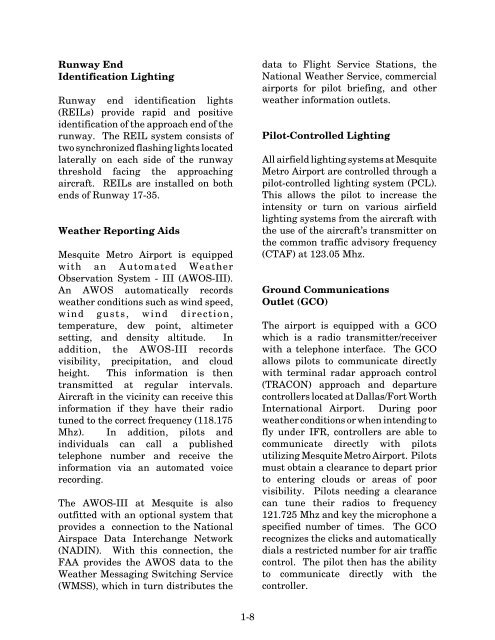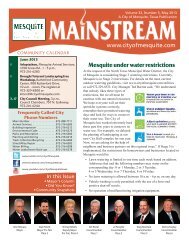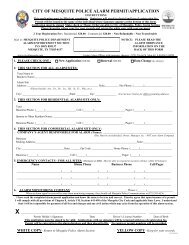airport/documents/Mesquite Master Plan Final.pdf - The City of ...
airport/documents/Mesquite Master Plan Final.pdf - The City of ...
airport/documents/Mesquite Master Plan Final.pdf - The City of ...
You also want an ePaper? Increase the reach of your titles
YUMPU automatically turns print PDFs into web optimized ePapers that Google loves.
Runway End<br />
Identification Lighting<br />
Runway end identification lights<br />
(REILs) provide rapid and positive<br />
identification <strong>of</strong> the approach end <strong>of</strong> the<br />
runway. <strong>The</strong> REIL system consists <strong>of</strong><br />
two synchronized flashing lights located<br />
laterally on each side <strong>of</strong> the runway<br />
threshold facing the approaching<br />
aircraft. REILs are installed on both<br />
ends <strong>of</strong> Runway 17-35.<br />
Weather Reporting Aids<br />
<strong>Mesquite</strong> Metro Airport is equipped<br />
with an Automated Weather<br />
Observation System - III (AWOS-III).<br />
An AWOS automatically records<br />
weather conditions such as wind speed,<br />
wind gusts, wind direction,<br />
temperature, dew point, altimeter<br />
setting, and density altitude. In<br />
addition, the AWOS-III records<br />
visibility, precipitation, and cloud<br />
height. This information is then<br />
transmitted at regular intervals.<br />
Aircraft in the vicinity can receive this<br />
information if they have their radio<br />
tuned to the correct frequency (118.175<br />
Mhz). In addition, pilots and<br />
individuals can call a published<br />
telephone number and receive the<br />
information via an automated voice<br />
recording.<br />
<strong>The</strong> AWOS-III at <strong>Mesquite</strong> is also<br />
outfitted with an optional system that<br />
provides a connection to the National<br />
Airspace Data Interchange Network<br />
(NADIN). With this connection, the<br />
FAA provides the AWOS data to the<br />
Weather Messaging Switching Service<br />
(WMSS), which in turn distributes the<br />
1-8<br />
data to Flight Service Stations, the<br />
National Weather Service, commercial<br />
<strong>airport</strong>s for pilot briefing, and other<br />
weather information outlets.<br />
Pilot-Controlled Lighting<br />
All airfield lighting systems at <strong>Mesquite</strong><br />
Metro Airport are controlled through a<br />
pilot-controlled lighting system (PCL).<br />
This allows the pilot to increase the<br />
intensity or turn on various airfield<br />
lighting systems from the aircraft with<br />
the use <strong>of</strong> the aircraft’s transmitter on<br />
the common traffic advisory frequency<br />
(CTAF) at 123.05 Mhz.<br />
Ground Communications<br />
Outlet (GCO)<br />
<strong>The</strong> <strong>airport</strong> is equipped with a GCO<br />
which is a radio transmitter/receiver<br />
with a telephone interface. <strong>The</strong> GCO<br />
allows pilots to communicate directly<br />
with terminal radar approach control<br />
(TRACON) approach and departure<br />
controllers located at Dallas/Fort Worth<br />
International Airport. During poor<br />
weather conditions or when intending to<br />
fly under IFR, controllers are able to<br />
communicate directly with pilots<br />
utilizing <strong>Mesquite</strong> Metro Airport. Pilots<br />
must obtain a clearance to depart prior<br />
to entering clouds or areas <strong>of</strong> poor<br />
visibility. Pilots needing a clearance<br />
can tune their radios to frequency<br />
121.725 Mhz and key the microphone a<br />
specified number <strong>of</strong> times. <strong>The</strong> GCO<br />
recognizes the clicks and automatically<br />
dials a restricted number for air traffic<br />
control. <strong>The</strong> pilot then has the ability<br />
to communicate directly with the<br />
controller.




